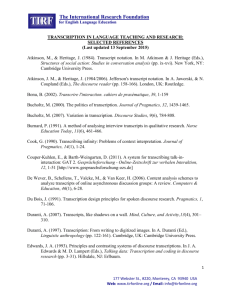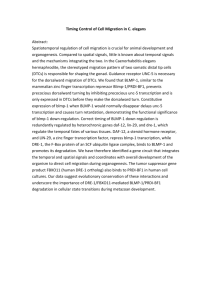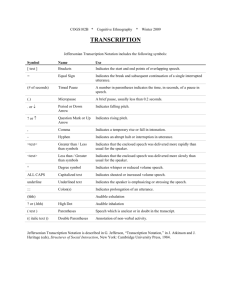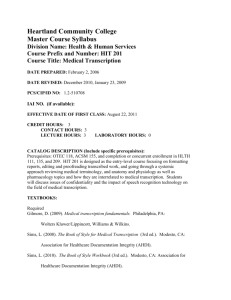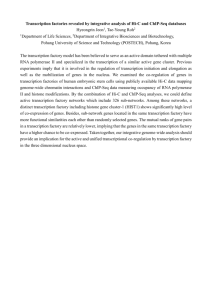The International Research Foundation
advertisement
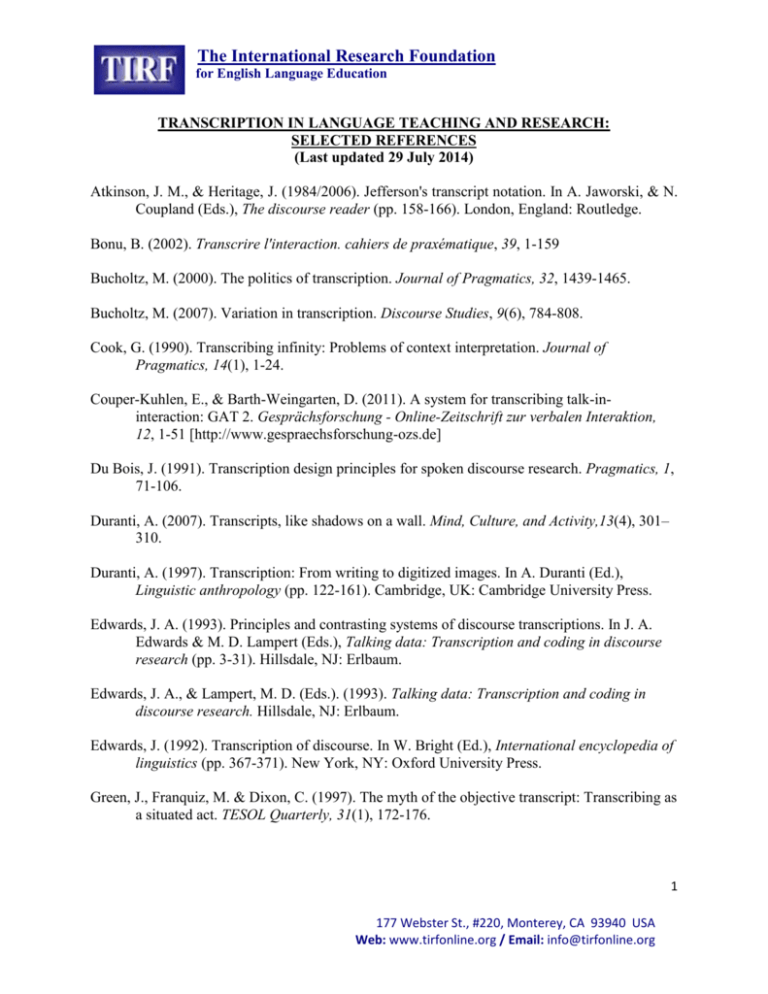
The International Research Foundation for English Language Education TRANSCRIPTION IN LANGUAGE TEACHING AND RESEARCH: SELECTED REFERENCES (Last updated 29 July 2014) Atkinson, J. M., & Heritage, J. (1984/2006). Jefferson's transcript notation. In A. Jaworski, & N. Coupland (Eds.), The discourse reader (pp. 158-166). London, England: Routledge. Bonu, B. (2002). Transcrire l'interaction. cahiers de praxématique, 39, 1-159 Bucholtz, M. (2000). The politics of transcription. Journal of Pragmatics, 32, 1439-1465. Bucholtz, M. (2007). Variation in transcription. Discourse Studies, 9(6), 784-808. Cook, G. (1990). Transcribing infinity: Problems of context interpretation. Journal of Pragmatics, 14(1), 1-24. Couper-Kuhlen, E., & Barth-Weingarten, D. (2011). A system for transcribing talk-ininteraction: GAT 2. Gesprächsforschung - Online-Zeitschrift zur verbalen Interaktion, 12, 1-51 [http://www.gespraechsforschung-ozs.de] Du Bois, J. (1991). Transcription design principles for spoken discourse research. Pragmatics, 1, 71-106. Duranti, A. (2007). Transcripts, like shadows on a wall. Mind, Culture, and Activity,13(4), 301– 310. Duranti, A. (1997). Transcription: From writing to digitized images. In A. Duranti (Ed.), Linguistic anthropology (pp. 122-161). Cambridge, UK: Cambridge University Press. Edwards, J. A. (1993). Principles and contrasting systems of discourse transcriptions. In J. A. Edwards & M. D. Lampert (Eds.), Talking data: Transcription and coding in discourse research (pp. 3-31). Hillsdale, NJ: Erlbaum. Edwards, J. A., & Lampert, M. D. (Eds.). (1993). Talking data: Transcription and coding in discourse research. Hillsdale, NJ: Erlbaum. Edwards, J. (1992). Transcription of discourse. In W. Bright (Ed.), International encyclopedia of linguistics (pp. 367-371). New York, NY: Oxford University Press. Green, J., Franquiz, M. & Dixon, C. (1997). The myth of the objective transcript: Transcribing as a situated act. TESOL Quarterly, 31(1), 172-176. 1 177 Webster St., #220, Monterey, CA 93940 USA Web: www.tirfonline.org / Email: info@tirfonline.org The International Research Foundation for English Language Education Goodwin, C. (1979). The interactive construction of a sentence in natural conversation. In G. Psathas (Ed.), Everyday language: Studies in ethnomethodology (pp. 97-121). New York, NY: Irvington Publishers. Goodwin, C. (1994). Recording human interaction in natural settings. Pragmatics, 3, 181-209. Have, P. T. (2002). Reflections on transcription. Cahiers de Praxématique, 39, 21-24. Retrieved from http://www.paultenhave.nl/Transcription-rv2.pdf Hepburn, A. (2004). Crying: Notes on description, transcription, and interaction. Research on Language and Social Interaction, 37, 251-290. Hepburn, A., & Bolden, G. B. (2013). The conversation analytic approach to transcription. Retrieved from http://www.academia.edu/1128693/Hepburn_A._and_Bolden_G._2013_._The_conversat ion_analytic_approach_to_transcription Jefferson, G. (1983). Issues in the transcription of naturally occurring talk: Caricature versus capturing pronunciational particulars. Tilburg Papers in Language and Literature, 34. Jefferson, G. (1984). Transcription notation. In J. M. Atkinson & J. Heritage (Eds.), Structures of social action (pp. ix-xvi). Cambridge, UK: Cambridge University Press. Jefferson, G. (1985). An exercise in the transcription and analysis of laughter. In T. A. v. Dijk(Ed.), Handbook of discourse analysis (Vol., 3, pp. 25-34). New York, NY: Academic Press. Jefferson, G. (2004). Glossary of transcript symbols with an introduction. In G. H. Lerner (Ed.), Conversation analysis: Studies from the first generation (pp. 13-31). Philadelphia, PA: John Benjamims. Jefferson, G. (1996). A case of transcriptional stereotyping. Journal of Pragmatics, 26, 159-170. Jenks, C. J. (2011). Transcribing talk and interaction: Issues in the representation of communication data. Amsterdam, The Netherlands: John Benjamins. Lane, L.A., Knippen, R. Denton, J. & Suslak, D. (1996). Reaching criterion in phonetic transcription: Validity and reliability of non-native speakers. In M. Meyerhoff (Ed.), (N) WAVES and MEANS: A selection of papers from NWAVE 24. University of Pennsylvania Working Papers in Linguistics, 3(1), 87-110. Laurier, E. (2014). The graphic transcript: Poaching comic book grammar for inscribing the visual, spatial and temporal aspects of action. Geography Compass, 8(4), 235-248. 2 177 Webster St., #220, Monterey, CA 93940 USA Web: www.tirfonline.org / Email: info@tirfonline.org The International Research Foundation for English Language Education Lynch T. (2005). Self-transcribing and noticing in EAP speaking classes. Edinburgh Working Papers in Applied Linguistics, 14, 54-67. Mishler, E.G. (1991). Representing discourse: The rhetoric of transcription. Journal of Narrative and Life History, 1(4), 255-280. MacWhinney, B., & Wagner, J. (2010). Transcribing, searching and data sharing: The CLAN software and the TalkBank data repository. Gesprächsforschung - Online-Zeitschrift zur verbalen Interaktion, 11, 154-173 (www.gespraechsforschung-ozs.de) Mondada, L. (2007). Commentary: Transcript variations and the indexicality of transcribing practices. Discourse Studies, 9, 809-821. Ochs, E. (1979). Transcription as theory. In E. Ochs & B. B. Schieffelin (Eds.) Developmental pragmatics (pp. 43-72). New York: Academic Press, Inc. O’Connell, D.C., & Kowal, S. (1994). Some current transcription systems for spoken discourse: A critical analysis. Pragmatics, 4, 81–107. Park, J. S. Y., & Bucholtz, M. (2009). Introduction. Public transcripts: Entextualization and linguistic representation in institutional contexts. Text & Talk--An Interdisciplinary Journal of Language, Discourse & Communication Studies, 29(5), 485-502. Psathas, G. & Anderson, T. (1990). The ‘practices’ of transcription in conversation analysis. Semiotica, 78(1/2), 75-99. Riessman, C. K. (2008). Narrative methods for the human sciences. Los Angeles: SAGE Publications. Roberts, C. (1997). Transcribing talk: Issues of representation. TESOL Quarterly, 31(1), 167172. Sherzer, J. (1994). Transcription, representation, and translation: Repetition and performance in Kuna discourse. In B. Johnstone (Ed.), Repetition in discourse: Interdisciplinary perspectives. (Vol. 1, pp. 37-52). Norwood, NJ: Abbex. Stillwell, C., Curabba, B., Alexander, K., Kidd, A., Kim, E., Stone, P., & Wyle, C. (2010). Students transcribing tasks: Noticing fluency, accuracy, and complexity. ELT Journal, 64(4), 445-455. Tedlock, D. (1990). From voice and ear to hand and eye. The Journal of American Folklore, 103, 133-156. 3 177 Webster St., #220, Monterey, CA 93940 USA Web: www.tirfonline.org / Email: info@tirfonline.org The International Research Foundation for English Language Education Traverso, V. (2002). Transcription et traduction des interactions en langue étrangère. Cahiers de Praxématique, 39, 77-99 Wortham, S. (2001). Narratives in action: A strategy for research and analysis. New York, NY: Teachers College Press. 4 177 Webster St., #220, Monterey, CA 93940 USA Web: www.tirfonline.org / Email: info@tirfonline.org

